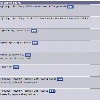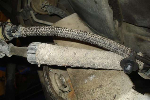- Joined
- November 11, 2005
- Messages
- 56,683
- Reaction score
- 1,186
- City, State
- Brooklyn, NY
- Year, Model & Trim Level
- 88 89 93 95 96 Aerostars
Alternators, and starters are generally pull, and replace kind of parts. Lets take a look at what makes alternators work (or not work).
Voltage from an alternator must be regulated in order to maintain a constant voltage. Passive voltage regulators such as the one in this picture only have an upper voltage limit.

They will only let the voltage go up to a predetermined threshold point, but will not regulate voltage when it drops. It will act like an electronic switch which applies full power to the rotor. It could only put out as much as is coming in. A weak battery will not apply enough voltage to step itself up. An active regulator will step voltage up while reducing current. This kind of regulator regulates voltage when it increases (sources), and when it drops (sinks). Computer power supplies use a similar kind of regulator as the one just mentioned (PWM or pulse width modulation). The internal regulator in this alternator is called a linear regulator. Some systems use negative voltage regulation while other systems use positive voltage regulation.
The regulator makes contact with the rotor through brushes.

This is a picture of the rotor:

The rotor has an assembly around it which works in a similar fashion as a transformer. It is called the stator. It does not move like the rotor.

The voltage coming off the stator is AC. It has to be rectified into DC to be used on automotive wiring. This task is accomplished by the diode trio which is connected directly to the stator as shown in this photo:

This is what it look like without the stator connected to it:

Now that this is explained, lets discuss the common problems with alternators.
Brushes are considered high wear parts. They are made out of carbon. The engine is constantly turning all of the time, and this wears down the carbon on the brushes as shown in this photo:

The carbon brushes on the top have gotten "shaved or sculpted" into the shape of the rotor's commutators (copper contacts in the rear). Brake pads, steering column clockspring contacts, horn contacts in older vehicles, and clutches, get worn down with use. A smaller pulley will turn faster, and wear the brushes down faster.

The advantage to the smaller pulley is that it allows the alternator to turn faster at idle. This helps maintain a constant voltage since the alternator is designed to operate at a minimum RPM rating. Some alternators will have problems maintaining the proper voltage at idle if the RPMs are a drop too low. There is a fan in the front on the older alternators to cool them down.

The front blade requires a safety shield:

The newer ones have an internal fan blade.
This is what it looks like after everything is back together again:

Voltage from an alternator must be regulated in order to maintain a constant voltage. Passive voltage regulators such as the one in this picture only have an upper voltage limit.
They will only let the voltage go up to a predetermined threshold point, but will not regulate voltage when it drops. It will act like an electronic switch which applies full power to the rotor. It could only put out as much as is coming in. A weak battery will not apply enough voltage to step itself up. An active regulator will step voltage up while reducing current. This kind of regulator regulates voltage when it increases (sources), and when it drops (sinks). Computer power supplies use a similar kind of regulator as the one just mentioned (PWM or pulse width modulation). The internal regulator in this alternator is called a linear regulator. Some systems use negative voltage regulation while other systems use positive voltage regulation.
The regulator makes contact with the rotor through brushes.
This is a picture of the rotor:
The rotor has an assembly around it which works in a similar fashion as a transformer. It is called the stator. It does not move like the rotor.
The voltage coming off the stator is AC. It has to be rectified into DC to be used on automotive wiring. This task is accomplished by the diode trio which is connected directly to the stator as shown in this photo:
This is what it look like without the stator connected to it:
Now that this is explained, lets discuss the common problems with alternators.
Brushes are considered high wear parts. They are made out of carbon. The engine is constantly turning all of the time, and this wears down the carbon on the brushes as shown in this photo:
The carbon brushes on the top have gotten "shaved or sculpted" into the shape of the rotor's commutators (copper contacts in the rear). Brake pads, steering column clockspring contacts, horn contacts in older vehicles, and clutches, get worn down with use. A smaller pulley will turn faster, and wear the brushes down faster.
The advantage to the smaller pulley is that it allows the alternator to turn faster at idle. This helps maintain a constant voltage since the alternator is designed to operate at a minimum RPM rating. Some alternators will have problems maintaining the proper voltage at idle if the RPMs are a drop too low. There is a fan in the front on the older alternators to cool them down.
The front blade requires a safety shield:
The newer ones have an internal fan blade.
This is what it looks like after everything is back together again:










